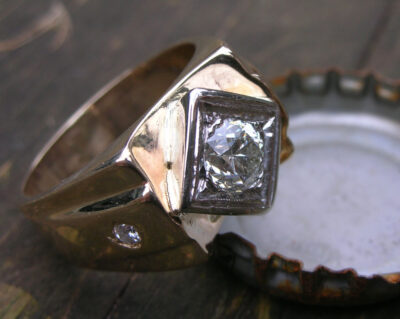Recognizing Bottle Caps with the Nokta Legend
No detector–even a sophisticated one like the Nokta / Makro Legend will take the place of basic skills and bottlecap responses are a good demonstration of why this is. I see one prominent “YouTube” personality who hears a sound, checks the consistency on the cross sweep and digs. While this is a good target testing start–adding a quick pinpoint mode check would greatly increase his accuracy by letting him get a better idea of where is targets are, what shape they are and how well they stand out from the surrounding ground.
These target features form the basis of what I call “correlation”–that is when you look for sets of target characteristics. This kind of approach takes a bit of practice but can improve your accuracy and hunt time usage a lot. Basically it keeps you off the “too bigs,” the “flyspecks,” the elongated objects and those objects that are partly iron. This type of a broad-based approach can help you to recognise any problem target–including bottlecaps.
As multi frequency machines became more sophisticated a problem arose with bottlecaps. Whereas with a single frequency detector most caps read at a particular part of the “ID” scale—the multiple frequencies of these more modern detectors all read the ground differently. This meant that the steel (or rust) part of a bottlecap could come in at any number of places on the “ID” scale. This confounded a lot of hunters in that it made caps harder to recognize just by “hearing and digging.” What ‘s needed are some other cap “tells” that involve basic skills.

These two targets have vastly different physical properites that can be recognized with practice. The ring is “clean” metal whereas the cap is a diverse alloy that contains iron or steel.
Several methods have emerged. The first involves moving the coil back off a target to listen for the iron tone to come in. This works because a cap signal is more blended with the surrounding ground and as the coil is moved off, the ground signal begins to dominate. This is not a bad method but does not work as well with those high responding caps that contain more aluminum. Quite a few beer brands (such as Heineken and Corona) fall into this category. Another problem is nearby iron could be what’s causing the low tone.
A second method involved turning up the Iron Volume. This makes the “surrounding” iron tone come in more loudly as the coil moves towards the target. This works but it makes the audio a bit loud and confusing overall. The way that these “blended-with-the-ground” signals respond is more obvious wtih the iron response turned up.
My suggestion is a bit of all of these methods but is simpler than any. It relies on the fact that a bottle cap is a “dogs breakfast” of metals. Using 60 Tones lets you hear these better. As well, any target that contains steel or rust is not a strong, solid tone. It’s not “peaked” in the middle. When you run (or switch to) 60 Tones cap signals are not centred. What you are hearing is the machine trying to “lock on” to a single conductive range and failing. As you move the coil off the signal and go to the cross sweep this process will begin again—and fail. The more rust a cap has the more quickly it will degrade as a centred response—that is–it will begin to break up. When you do repeat coil passes, it won’t pick up uniformly. As you move the coil around trying to get a fix on the target –the centre will appear to move. With practice in 60 Tones—the properties of a cap or iron target will be easier to spot in any tone “ID” mode including the segmented ones (2, 4 and 6). You can also combine this information with watching the meter readings for scattered number in the cap ranges. I find these to be around “20-21,” “27-30” and sometimes up higher for the ones with more aluminum. At the same time the coil will always reveal the inconsistencies of these targets.
So you are learning to recognize both the alloying and the steel content’s blending with the surrounding ground’s signal. The less “peaked” a signal’s tone is, the less distinct from the ground it is. Combine this with listening for transitioning, inconsistent tones in response to your coil movments.
In soil I also use pinpoint mode to see if a signal is wide (containing iron or steel) or drawn out. The “FerraCheck” is also a handy tool for recognizing caps. It’s also dependant upon coil control in that the iron side meter may not show bars on every pass. These may just flicker in and it’s necssary to remove the target completely from the detection field to get an accurate reading. Use the cross sweep and check the graph when the signal is the loudest.
Its only when you learn to use the coil this way that the real benefits of a multi frequency machine come into focus. These simple tests tell you if something is consistent enough to be any metal object of value.
These are the kinds of simple, basic skills that will save you needless digging and help you to get the most from the Legend.
For more information on getting results at your hunt sites with the Nokta Legend metal detector, check out the reviews on my book below:
“A Beginner’s Guide to the Nokta / Makro Legend Metal Detector, “
Good Luck Detecting,
cjc